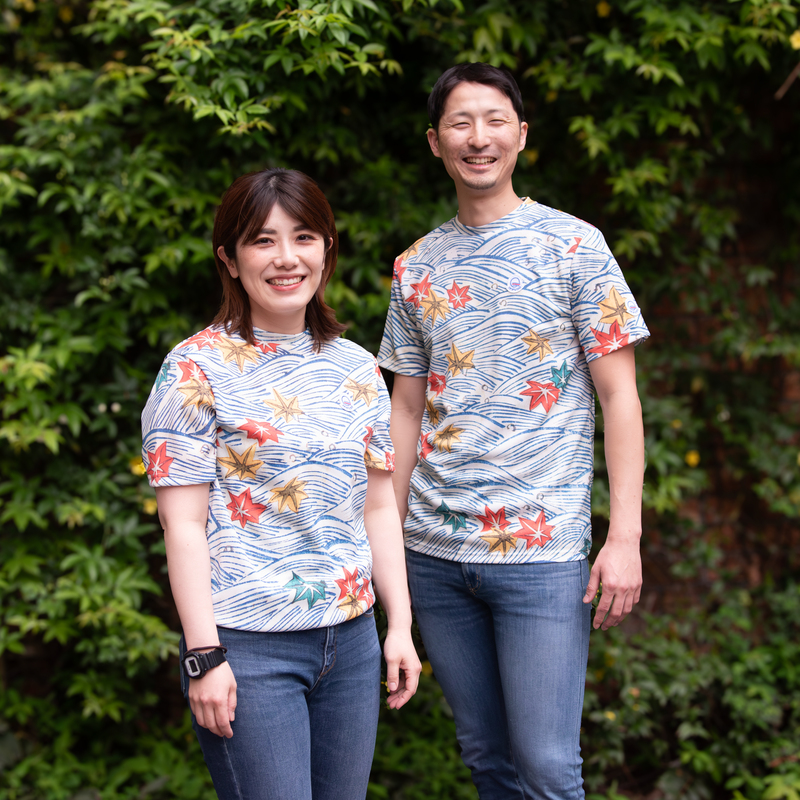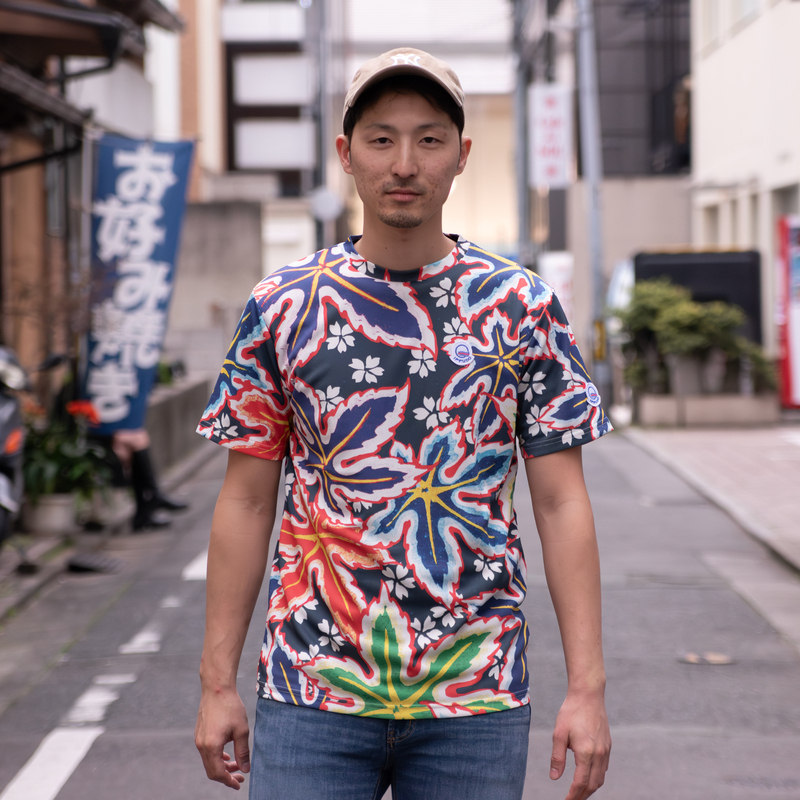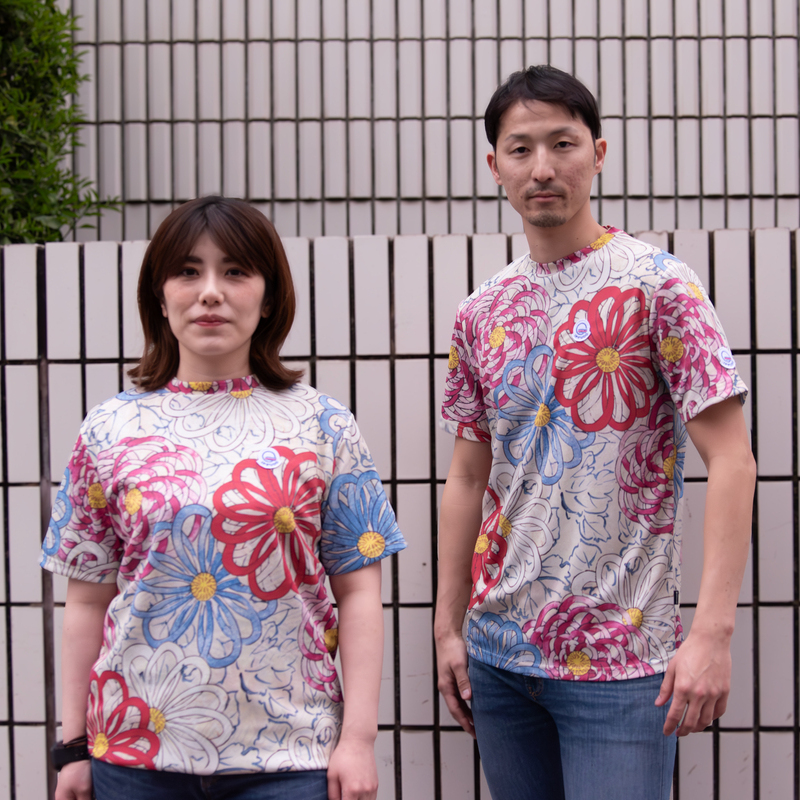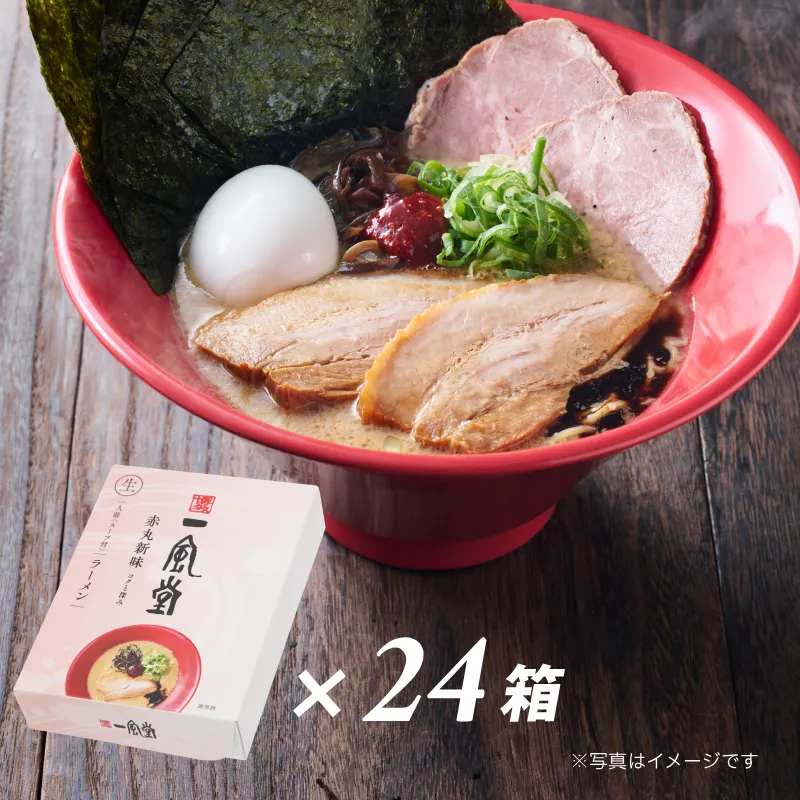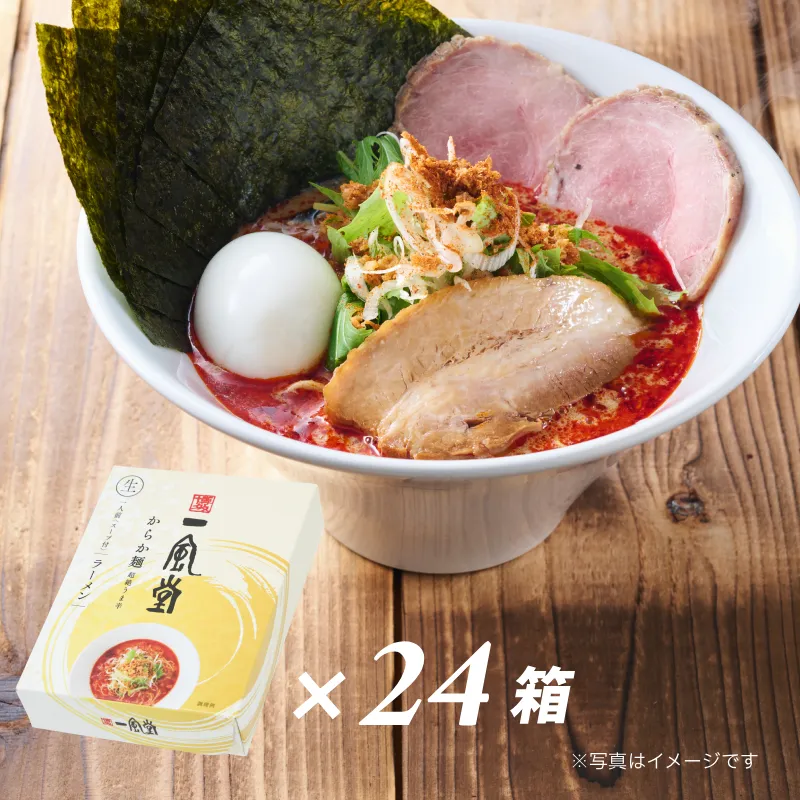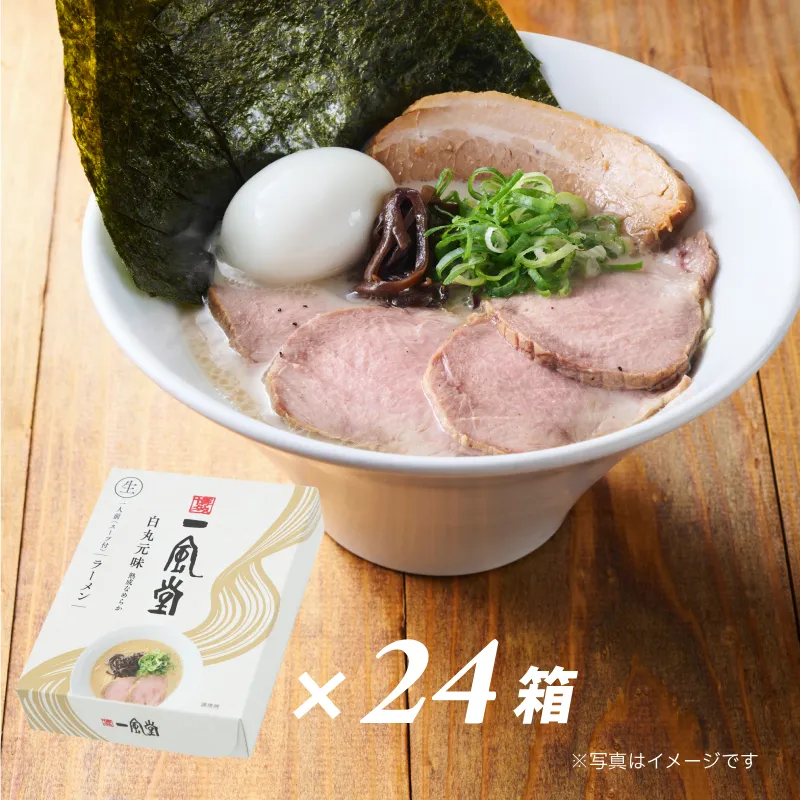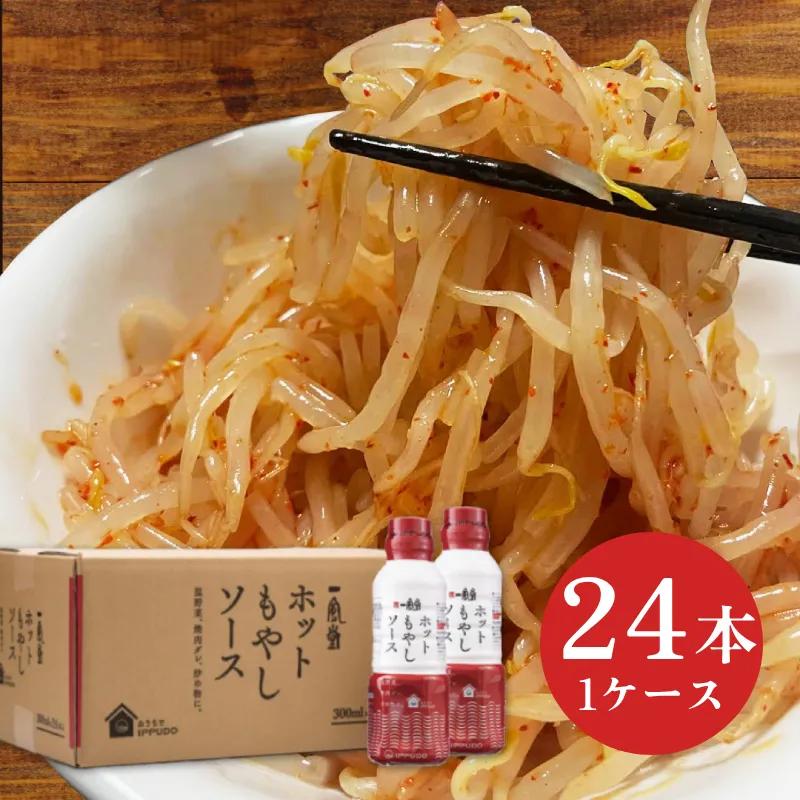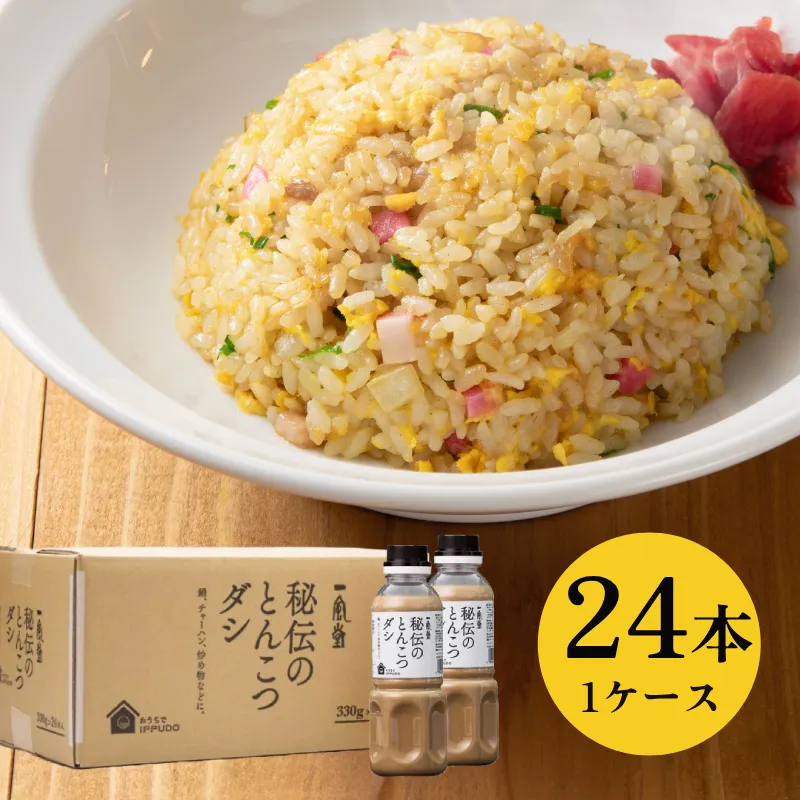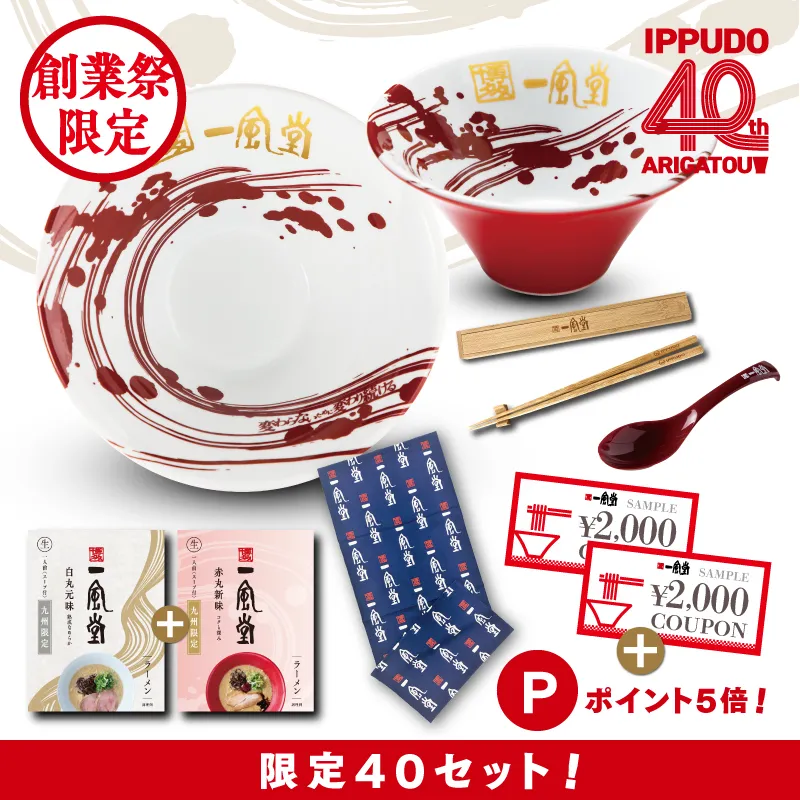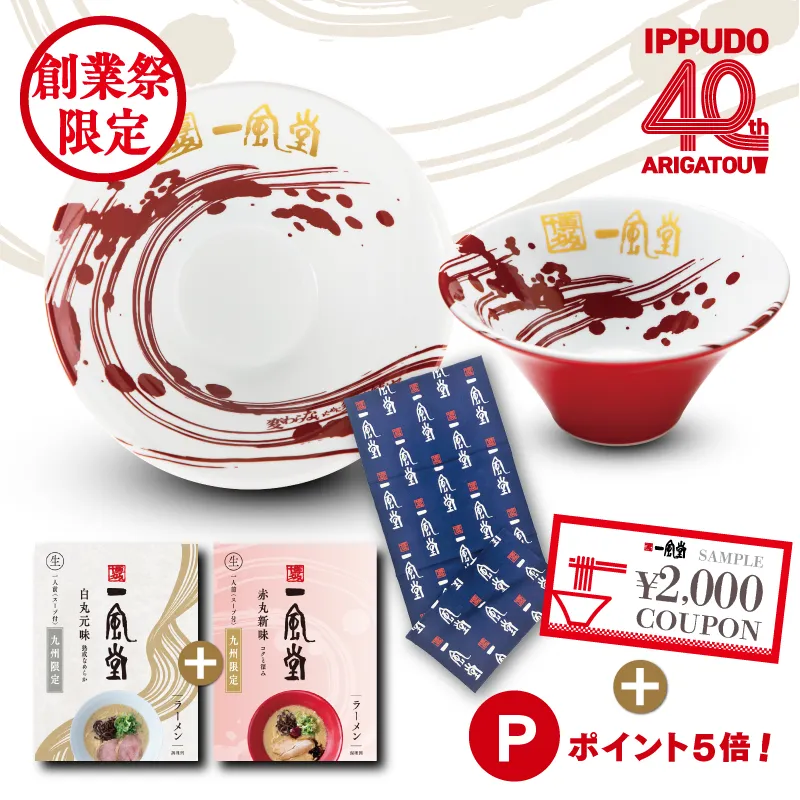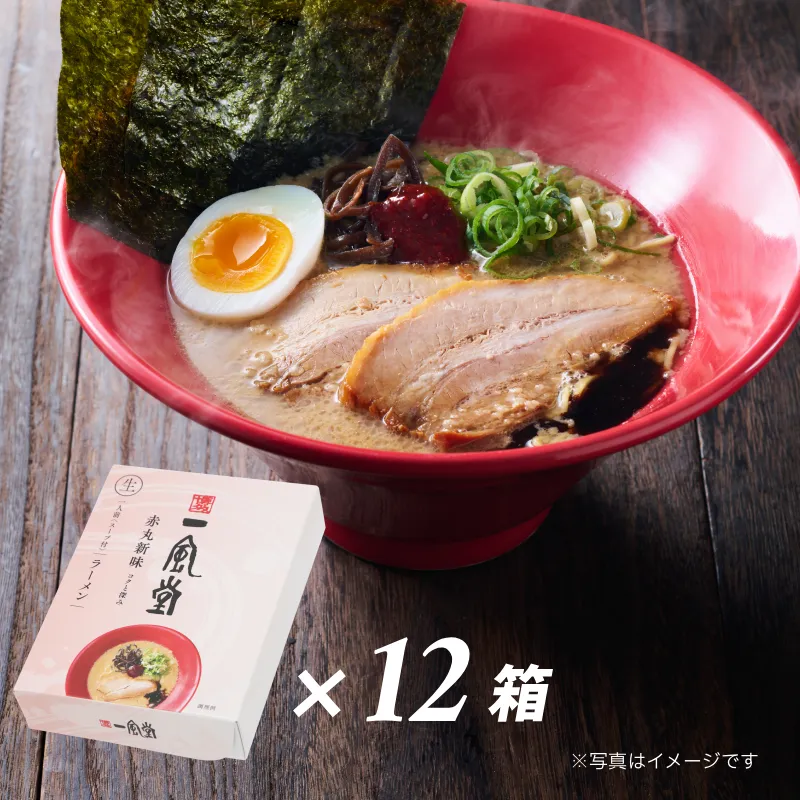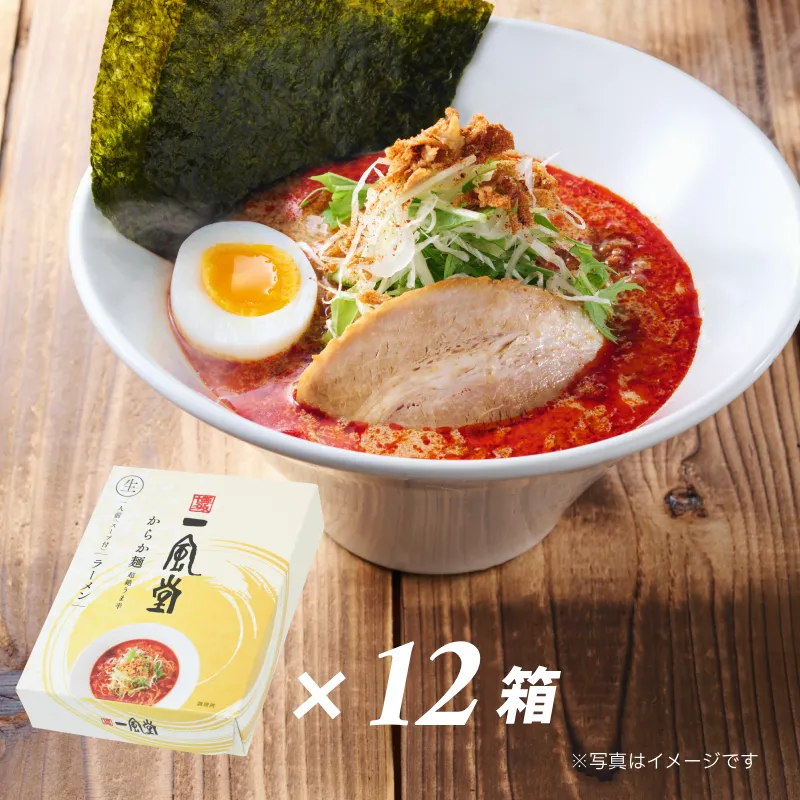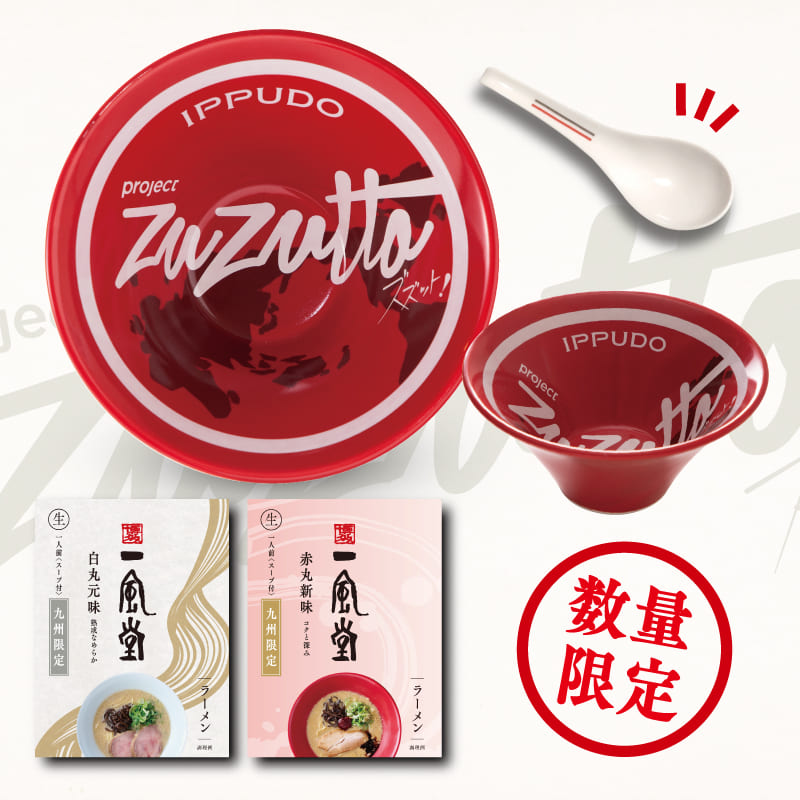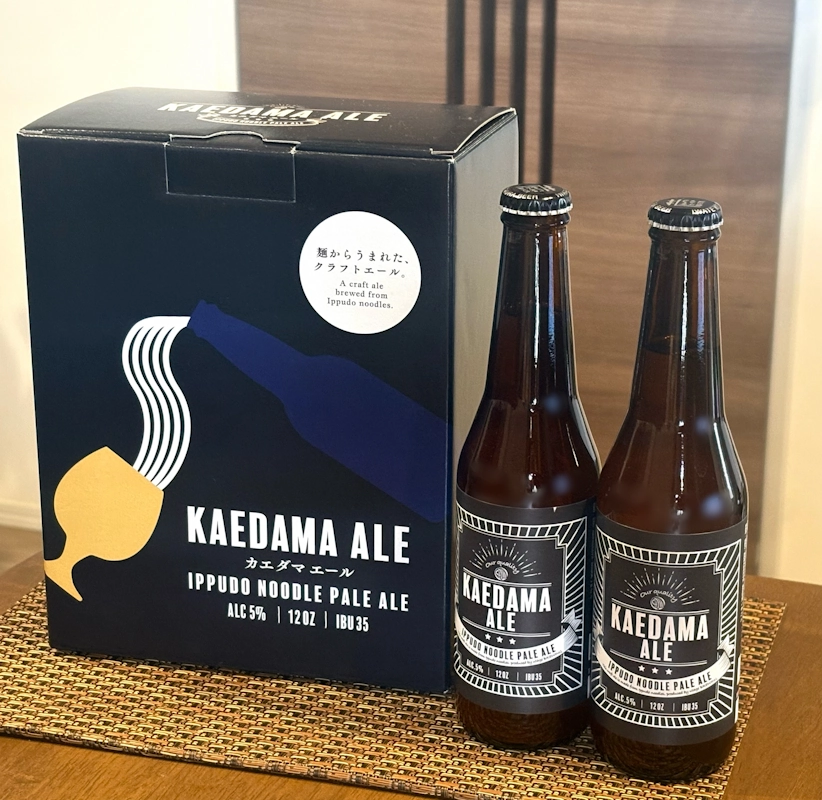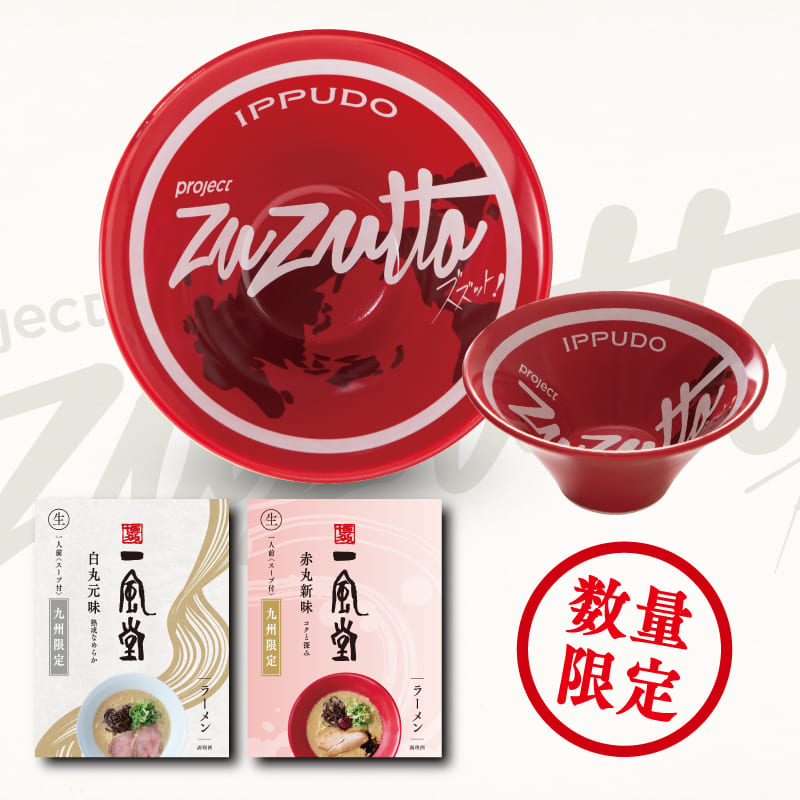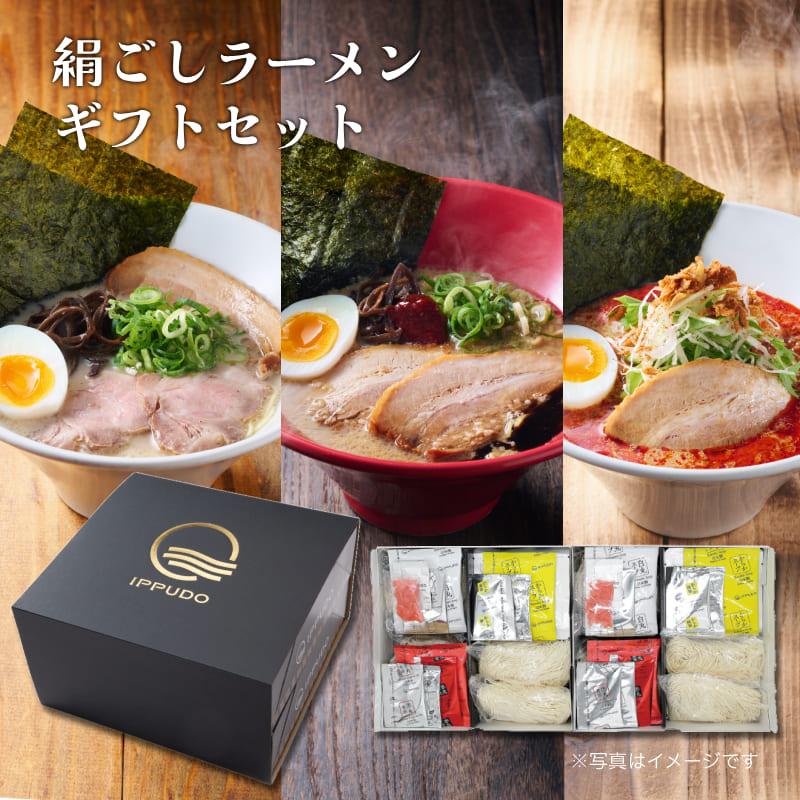一風堂
-
(Sサイズ 竜田川文)一風堂×EPSON×タカレンプロデュース。サステナブルな製法で、着心地もおしゃれも叶うTシャツができました。品番2:bda0020-01a販売価格:¥20,000在庫:○
白丸よりやさしいTシャツできました。
一風堂創業者 河原成美がセレクトした全3種を限定販売。
サステナブルな製法で、着心地もおしゃれも叶うTシャツができました。
Tシャツに描く模様には京都で150年前に使われていた吉祥文様を使用。 過去から今、そしてより良い未来へと繋いでいく1着です。
詳細はこちら竜田川文に込められた想い
流水に紅葉が流れる風景を意匠化した文様です。 奈良県の竜田川が紅葉の名所であることからその名がつけられました。 古今和歌集には「竜田川 もみぢ乱れて流るめり 渡らば錦 中やたえなむ」と、 その美しさを錦(高貴な織物)になぞらえ詠まれています。Tatsutagawa-mon(Tatsuta-gawa River pattern)
This pattern is designed to depict a land-scape of autumn leaves flowing in running water. Its name comes from the Tatsuta-gawa River in Nar a Prefecture, which is famous for its autumn leaves. In the Kokin Wakashu, its beauty is likened to brocade (a noble t extile): “Autumn leaves flow in turbulence on the Tatsutagawa River, and if I cr oss it, the brocade will likely break in the middle.” -
(Sサイズ 雲錦文)一風堂×EPSON×タカレンプロデュース。サステナブルな製法で、着心地もおしゃれも叶うTシャツができました。品番2:bda0020-04a販売価格:¥20,000在庫:○
白丸よりやさしいTシャツできました。
一風堂創業者 河原成美がセレクトした全3種を限定販売。
サステナブルな製法で、着心地もおしゃれも叶うTシャツができました。
Tシャツに描く模様には京都で150年前に使われていた吉祥文様を使用。 過去から今、そしてより良い未来へと繋いでいく1着です。
詳細はこちら雲錦文に込められた想い
春秋を代表する桜と紅葉を合わせた文様です。 桜を雲に、紅葉を錦(高貴な織物)に見立てていることから「雲錦」と呼ばれています。 四季の移ろいを楽しむ日本人ならではの、 色づく紅葉を愛でる気持ちと桜を待ちこがれる期待感を大胆に表現しています。Unkin-mon (Cloud Brocade pattern)
This is a pattern that combines cherry blossoms and autumn leaves, which are representative of spring and autumn. It is called "unkin" (meaning "cloud brocade") because the cherry blossoms are likened to clouds and the autumn leaves are likened to brocade (a noble textile). It boldly expresses the feeling of admiring the changing colors of autumn leaves and eagerly looking forward to the cherry blossoms, which is unique to Japanese people who enjoy the changing seasons. -
(Sサイズ 菊文)一風堂×EPSON×タカレンプロデュース。サステナブルな製法で、着心地もおしゃれも叶うTシャツができました。品番2:bda0020-07a販売価格:¥20,000在庫:○
白丸よりやさしいTシャツできました。
一風堂創業者 河原成美がセレクトした全3種を限定販売。
サステナブルな製法で、着心地もおしゃれも叶うTシャツができました。
Tシャツに描く模様には京都で150年前に使われていた吉祥文様を使用。 過去から今、そしてより良い未来へと繋いでいく1着です。
詳細はこちら菊文に込められた想い
菊は、奈良時代に薬草として日本に伝わり、 平安時代には「重陽の節句」に菊花の宴をひらいて、 無病息災や延命長寿を願うようになりました。 繊細な葉のデザインを背景に、飾り結びをイメージした菊の花をあしらった華やかな吉祥文様です。Kiku-mon (Chrysanthemum pattern)
Chrysanthemums were introduced to Japan as a medicinal herb during the Nara period, and during the Heian period, chrysanthemum banquets came to be held during the Chrysanthemum Festival to pray for good health and longevity. This is a gorgeous auspicious pattern with chrysanthemum flowers, inspired by decorative knots and set against a delicate leaf design. -
【さらに美味しくなってリニューアルしました】醤油のコクに、ガーリックが効いた香油、特製の辛味噌。最後の一滴までスープの味わいと深みを楽しめます。品番2:s-baa0002-24a販売価格:¥14,820在庫:○醤油のコクに、ガーリックが効いた香油、特製の辛味噌。最後の一滴までスープの味わいと深みを楽しめます。白丸が正統派ならば、赤丸はとんこつラーメンの可能性を広げた革新派。
※ 調理画像はイメージです。詳細は原材料をご確認ください -
【美味しくなってリニューアル】なめらかなとんこつスープに特製のスパイスを合わせ、辛みとコクを加えた、じわりと汗をかく辛さがたまらない刺激的なとんこつラーメンです。品番2:s-baa0003-24a販売価格:¥14,820在庫:○1989年、大名本店で誕生。なめらかなとんこつスープに特製のスパイスを合わせ、辛みとコクを加えます。特製の肉味噌、水菜や白ネギで、食感も楽しく。麻辣の、じわりと汗をかく辛さがたまらない刺激的なとんこつラーメンです。
※ 調理画像はイメージです。詳細は原材料をご確認ください -
【さらに美味しくなってリニューアルしました】創業当時から今に引き継ぐ一風堂の本流であり、原点の味。なめらかなとんこつスープに、博多らしい歯切れのよい細麺がよく合います。品番2:s-baa0001-24a販売価格:¥13,450在庫:○創業当時から今に引き継ぐ一風堂の本流であり、原点の味。なめらかなとんこつスープに、博多らしい歯切れのよい細麺がよく合います。
「紅しょうが&ペッパー」トッピングで、より博多ラーメンらしさのある一杯に。一風堂が求める麺の食感を再現し、基だしのコク、醤油感アップでより本格的な味に仕上げました。
※ 調理画像はイメージです。詳細は原材料をご確認ください -
【まとめ買い5%割引】ハマる人続出! 隠れた人気メニュー「辛もやし」がこれ1本で簡単に作れます。温野菜や冷奴、何にでも合うピリ辛ソースが食欲をそそります。 毎日の料理の味付けに、これだけあれば安心です。品番2:s-bca0003-24a販売価格:¥10,710在庫:○
-
【まとめ買い5%割引】お料理に加えるだけで旨くなる! 野菜炒め、チャーハン などアレンジレシピはいろいろ。 ご家庭の料理を一風堂のとんこつでワンランクアップ。 とんこつ好きには、毎日使える24本セット。品番2:s-bca0005-24a販売価格:¥10,710在庫:○お鍋も炒め物もチャーハンも…これさえあれば簡単楽チン!
とんこつ鍋、野菜炒め、チャーハンの他にお料理の隠し味などにもお使いいただけます。
たっぷり1ケース 24本入り
まとめ買いがお得!
1回のご注文5,000円(税込)以上で、送料を無料サービス致します。 -
SOLD OUT第2弾は一風堂の「創業の精神」が刻まれた逸品。人気のラーメンと手ぬぐい・竹箸・レンゲをセットに、一風堂を存分にお楽しみください。品番2:s-bda0023-c販売価格:¥10,000在庫:×
こちらの商品は10月24日以降順次発送です
― 一風堂「創業の精神」が刻まれた逸品 ―
「創業の想い」と、麺線をイメージしたあしらい。
「一風堂」を体現した丼です。
数量限定、創業祭だけの特別品をぜひ贈り物やご自宅用にお買い求めください。― 変わらないために、変わり続ける ―
「変わらないために、変わり続ける。」これは一風堂が創業時から掲げている、経営理念です。そしてこの度、一風堂は2025年でおかげさまで創業40周年を迎えることが出来ました。
一風堂が老舗と呼ばれるにはまだまだ長い年月が必要です。2035年、50周年。2085年、100周年。そんな先の未来を予測するのは簡単なことではありませんが、ただひとつ「絶対に変わらない」と確信できることがあります。
それは常に“一杯のラーメンを、一人のお客さまに”お出しする姿勢を頑なに守り続けるということです。未来の老舗、一風堂。将来、立派な老舗と認めていただけるように、一風堂は「変わらないもの」を見つめ、そのために日々変わり続けます。― オリジナルデザインの手ぬぐい ―
吸水性・速乾性に優れた綿100%の本格仕様。
一風堂ロゴをスタイリッシュにデザインしたオリジナル手ぬぐい。
ハンカチ、タオル、ランチョンマット、風呂敷など、用途は無限大。
モダンなデザインなので、ペットボトルホルダーやバッグの目隠しにもぴったり。
アイデア次第で、毎日を豊かに彩るマルチユースな一枚です。― オリジナルデザインの竹箸 ―
【非売品】オリジナルの一風堂竹箸をご用意しました。
素材は竹を使用しており、高級感を感じられる一品です。
※ロゴ「一風堂」「IPPUDO」「丼マーク」の3種類ですが発送はランダムです。商品は選べません― 日常使いにオススメ!一風堂カラーのレンゲ ―
プラスチック製で日常使いにオススメのロゴ入りレンゲです。― 次回使える”2,000円OFFクーポンを2回分”進呈 ―
\ オフィシャルオンラインストアのみで使える /
2,000円OFFクーポンを2回分進呈いたします♪
※おひとり様につき2回のみです(複数個ご購入いただいてもご利用は2回のみです)
※ご利用には無料会員登録が必要です
※1回4,000円以上のご注文につき2,000円値引きいたします
※商品代金の一部または全部のみが対象です
※商品代金が4,000円未満のご利用も1回とカウントされます
― 原点の一杯 とんこつラーメン白丸 ―
創業当時から今に引き継ぐ一風堂の本流であり、原点の味。豚骨の旨味を極限まで抽出した豊かで薫り高いシルキーなスープに、博多らしい細麺がマッチします。
麺には福岡県がラーメンのために開発した小麦「ラー麦」を使用。さらにチャーシューが付いた本格的な一品です。― 革新の一杯 とんこつラーメン赤丸 ―
醤油のコクに、ガーリックが効いた香油、特製の辛味噌。最後の一滴までスープの味わいと深みを楽しめます。白丸が正統派ならば、赤丸はとんこつラーメンの可能性を広げた革新派。
九州限定品の本商品は白丸と同じく麺には「ラー麦」を使用。さらにチャーシュー付きで満足のいく一品です。
※ 調理画像はイメージです。詳細は原材料をご確認ください -
第2弾は一風堂の「創業の精神」が刻まれた逸品。九州限定パッケージのラーメンとオリジナル手ぬぐいをセットに、一風堂をよりお楽しみください。品番2:s-bda0023-b販売価格:¥8,000在庫:○
こちらの商品は10月24日以降順次発送です
― 一風堂「創業の精神」が刻まれた逸品 ―
「創業の想い」と、麺線をイメージしたあしらい。
「一風堂」を体現した丼です。
数量限定、創業祭だけの特別品をぜひ贈り物やご自宅用にお買い求めください。― 変わらないために、変わり続ける ―
「変わらないために、変わり続ける。」これは一風堂が創業時から掲げている、経営理念です。そしてこの度、一風堂は2025年でおかげさまで創業40周年を迎えることが出来ました。
一風堂が老舗と呼ばれるにはまだまだ長い年月が必要です。2035年、50周年。2085年、100周年。そんな先の未来を予測するのは簡単なことではありませんが、ただひとつ「絶対に変わらない」と確信できることがあります。
それは常に“一杯のラーメンを、一人のお客さまに”お出しする姿勢を頑なに守り続けるということです。未来の老舗、一風堂。将来、立派な老舗と認めていただけるように、一風堂は「変わらないもの」を見つめ、そのために日々変わり続けます。― オリジナルデザインの手ぬぐい ―
吸水性・速乾性に優れた綿100%の本格仕様。
一風堂ロゴをスタイリッシュにデザインしたオリジナル手ぬぐい。
ハンカチ、タオル、ランチョンマット、風呂敷など、用途は無限大。
モダンなデザインなので、ペットボトルホルダーやバッグの目隠しにもぴったり。
アイデア次第で、毎日を豊かに彩るマルチユースな一枚です。― 次回使える”2,000円OFFクーポンを1回分”進呈 ―
\ オフィシャルオンラインストアのみで使える /
2,000円OFFクーポンを1回分進呈いたします!
※おひとり様につき1回のみです(複数個ご購入いただいてもご利用は1回のみです)
※ご利用には無料会員登録が必要です
※1回4,000円以上のご注文につき2,000円値引きいたします
※商品代金の一部または全部のみが対象です
※商品代金が4,000円未満のご利用も1回とカウントされます
― 原点の一杯 とんこつラーメン白丸 ―
創業当時から今に引き継ぐ一風堂の本流であり、原点の味。豚骨の旨味を極限まで抽出した豊かで薫り高いシルキーなスープに、博多らしい細麺がマッチします。
麺には福岡県がラーメンのために開発した小麦「ラー麦」を使用。さらにチャーシューが付いた本格的な一品です。― 革新の一杯 とんこつラーメン赤丸 ―
醤油のコクに、ガーリックが効いた香油、特製の辛味噌。最後の一滴までスープの味わいと深みを楽しめます。白丸が正統派ならば、赤丸はとんこつラーメンの可能性を広げた革新派。
九州限定品の本商品は白丸と同じく麺には「ラー麦」を使用。さらにチャーシュー付きで満足のいく一品です。
※ 調理画像はイメージです。詳細は原材料をご確認ください -
【さらに美味しくなってリニューアルしました】醤油のコクに、ガーリックが効いた香油、特製の辛味噌。最後の一滴までスープの味わいと深みを楽しめます。品番2:s-baa0002-12a販売価格:¥7,560在庫:○醤油のコクに、ガーリックが効いた香油、特製の辛味噌。最後の一滴までスープの味わいと深みを楽しめます。白丸が正統派ならば、赤丸はとんこつラーメンの可能性を広げた革新派。
※ 調理画像はイメージです。詳細は原材料をご確認ください -
【美味しくなってリニューアル】なめらかなとんこつスープに特製のスパイスを合わせ、辛みとコクを加えた、じわりと汗をかく辛さがたまらない刺激的なとんこつラーメンです。品番2:s-baa0003-12a販売価格:¥7,560在庫:○1989年、大名本店で誕生。なめらかなとんこつスープに特製のスパイスを合わせ、辛みとコクを加えます。特製の肉味噌、水菜や白ネギで、食感も楽しく。麻辣の、じわりと汗をかく辛さがたまらない刺激的なとんこつラーメンです。
※ 調理画像はイメージです。詳細は原材料をご確認ください -
SOLD OUT【年内発送12/28 am8:00ご注文分まで受付中】信州の年越しそばと、博多の年明けラーメンの豪華セット!品番2:s-aea0002-01a販売価格:¥6,980
※蕎麦の賞味期限は冷蔵約1週間程度です。
※年越しそばとしてご利用の方は、【年越出荷(12/23~12/27の発送)】をご指定ください。
※配達日指定のない場合、最短発送いたします。年越しそば
年越しそばには、そば粉を厳選して更に美味しくなった「二八そば」
そば職人や全国のそば通からも評判の良い「玄そばの最高峰」ともいわれている常陸秋そばを100%使用。
生そばにこだわるお客様にご納得いただける「二八生そば」に昇華しました。
生そばの食感、のど越し、風味を存分に堪能していただけます!
渡辺製麺のそばによく合う、自家製そばつゆでお召し上がりください。年明けラーメン
年明けラーメンには、一風堂のとんこつラーメン「白丸」「赤丸」
ひとつの鍋で手軽に調理でき、なにかと忙しい正月もゆっくり過ごせます。
辛子たかな、辛もやしのトッピングでおうちで一風堂気分に♪
麺から生まれたクラフトビール「替玉エール」は、新年のお祝いにもぴったりです。
年越しそばで1年を締めくくり、
年明けラーメンで新年をお過ごしください。
もちろん年越しそばならぬ、年越しラーメンもアリです! -
【さらに美味しくなってリニューアルしました】創業当時から今に引き継ぐ一風堂の本流であり、原点の味。なめらかなとんこつスープに、博多らしい歯切れのよい細麺がよく合います。品番2:s-baa0001-12a販売価格:¥6,860在庫:○創業当時から今に引き継ぐ一風堂の本流であり、原点の味。なめらかなとんこつスープに、博多らしい歯切れのよい細麺がよく合います。
「紅しょうが&ペッパー」トッピングで、より博多ラーメンらしさのある一杯に。一風堂が求める麺の食感を再現し、基だしのコク、醤油感アップでより本格的な味に仕上げました。
※ 調理画像はイメージです。詳細は原材料をご確認ください -
第1弾はラーメンを世界へ広める一風堂プロジェクト名をデザイン化!九州限定パッケージのラーメンに、オリジナルレンゲをプラス。一風堂をご家庭で存分にお楽しみいただけます。品番2:s-bda0022-b販売価格:¥6,760在庫:○
第1弾は、ラーメンを世界へ広める一風堂プロジェクト名をデザイン化!
九州限定パッケージのラーメンとセットに、一風堂をご家庭でお楽しみいただけます。― 4年の時を経て復活 オリジナル丼【zuzutto】 ―
一風堂のオリジナル丼は2022年に登場した特別なデザインが施された限定丼シリーズ。第1弾から第4弾まで展開され、それぞれテーマに沿った一風堂らしいデザインを採用。 オンラインストア限定商品で、発売当初からご好評をいただき完売となりました。今回、多くのお客様から再販希望のお声をいただき4年の時を経て待望の復刻が実現。 ラーメンをより美味しく、そして楽しく味わうための器として、またコレクションアイテムとしても魅力的なこの丼シリーズ。 数量限定の再登場です。ぜひこの機会をお見逃しなく。― project "zuzutto" とは ―
「zuzutto」は、一風堂がラーメン文化を世界に広めるために使っているキーワード。麺をすする音「ズズッ」が由来です。 麺をすすることでスープの味をより感じられ、香りも鼻に抜けて美味しさが増すという、 日本独自の食べ方の魅力を世界中に伝えるためのプロジェクトです。―EC限定オリジナルデザインの陶器レンゲ ―
一風堂カラーをあしらったオリジナルレンゲ。一風堂の丼と同じ窯元で製造している有田焼なので、安心して長く使えます。― 原点の一杯 とんこつラーメン白丸 ―
創業当時から今に引き継ぐ一風堂の本流であり、原点の味。豚骨の旨味を極限まで抽出した豊かで薫り高いシルキーなスープに、博多らしい細麺がマッチします。
麺には福岡県がラーメンのために開発した小麦「ラー麦」を使用。さらにチャーシューが付いた本格的な一品です。― 革新の一杯 とんこつラーメン赤丸 ―
醤油のコクに、ガーリックが効いた香油、特製の辛味噌。最後の一滴までスープの味わいと深みを楽しめます。白丸が正統派ならば、赤丸はとんこつラーメンの可能性を広げた革新派。
九州限定品の本商品は白丸と同じく麺には「ラー麦」を使用。さらにチャーシュー付きで満足のいく一品です。
※ 調理画像はイメージです。詳細は原材料をご確認ください -
【3月上旬頃より順次発送】「初音ミク×博多一風堂 39+1コラボキャンペーン」のラーメンどんぶりセットが登場!品番2:bda0091販売価格:¥6,600在庫:○

一風堂40周年を記念して、初音ミクとの夢のコラボレーションが実現!
一風堂オフィシャルオンラインストアにて、コラボオリジナルグッズの受注販売を開始いたします。
「初音ミク×博多一風堂 39+1コラボキャンペーン」のラーメンどんぶりセットが登場!
ご注文いただいた商品は、2026年3月上旬頃より順次出荷予定です。― 記念の一品 一風堂 × 初音ミク コラボグッズ ―
一風堂のユニフォームをまとった店員風の初音ミクと、ラーメンをモチーフにした髪飾りをつけた袴姿の初音ミクが登場。
一風堂40周年を祝う特別デザインで、ファン必見のコレクションです。
店舗で好評販売中の「アクリルスタンド(2種)」と「缶バッジセット(2個入り)」に加え、オンライン限定・受注生産アイテムとして、 「B1ハーフタペストリー(2種)」「ミニアクリルスタンド(全6種)」「ラーメンどんぶりセット(1種)」が登場!

初音ミクと一風堂の世界観が融合した、特別なアイテムをぜひお楽しみください。
オリジナルコラボラーメンセットも、近日登場予定!
― 味わいの一杯 一風堂 × 初音ミク ラーメンセット ―
一風堂の人気ラーメン「白丸」「赤丸」を食べ比べできる、贅沢な2食入りセットです。
【コラボ限定のこだわり】
・オリジナルアクリルコースター付き!
・コラボ限定デザインの海苔入り!
・初音ミクコラボ仕様のスペシャルパッケージ!
見て楽しい、食べておいしい、ここでしか手に入らない特別なコラボセット。
ぜひ一風堂オフィシャルオンラインストアでチェックしてください。
※ 商品画像はイメージです。 -
第2弾は一風堂の「創業の精神」が刻まれた逸品。品番2:bda0023販売価格:¥6,000在庫:○
こちらの商品は10月24日以降順次発送です
― 一風堂「創業の精神」が刻まれた逸品 ―
「創業の想い」と、麺線をイメージしたあしらい。
「一風堂」を体現した丼です。
数量限定、創業祭だけの特別品をぜひ贈り物やご自宅用にお買い求めください。― 変わらないために、変わり続ける ―
「変わらないために、変わり続ける。」これは一風堂が創業時から掲げている、経営理念です。そしてこの度、一風堂は2025年でおかげさまで創業40周年を迎えることが出来ました。
一風堂が老舗と呼ばれるにはまだまだ長い年月が必要です。2035年、50周年。2085年、100周年。そんな先の未来を予測するのは簡単なことではありませんが、ただひとつ「絶対に変わらない」と確信できることがあります。
それは常に“一杯のラーメンを、一人のお客さまに”お出しする姿勢を頑なに守り続けるということです。未来の老舗、一風堂。将来、立派な老舗と認めていただけるように、一風堂は「変わらないもの」を見つめ、そのために日々変わり続けます。
※ 調理画像はイメージです。詳細は原材料をご確認ください -
新登場!贈り物に最適なギフトボックスを採用。麺からうまれた、後味すっきりなビアスタイルをお楽しみください。品番2:bda0026販売価格:¥5,980在庫:○
大切な人に贈る、ホップでポップなビールギフトBOX
麺からうまれた後味すっきりなビアスタイル。
ラーメンのスープやチャーシューに調和するボディー感とキレ、ホップ由来の柑橘の香りが最後に押し寄せる、後味すっきりなビアスタイル。
ペールエールより飲み応えがありつつも、IPAよりも軽快で爽やかな、いいとこ取りのビールです。【UTAGE BREWINGについて】
乾杯からはじまるコミュニケーション、卓を囲む楽しさ、感じる音楽、癒される疲れ。 そんなビールの素晴らしさを体現できる「UTAGE」は、年齢や国籍を問わず、さまざまな人が集う場所。 ビールを片手にもてば、そこに広がるビールの輪、流れる特別な時間。そんな世界を目指す「UTAGE BREWING」は、 もっと長くビールを楽しむために、ビールを育む大地を称賛し、サスティナブルなクラフトビールへの挑戦を行っています。
UTAGE BREWINGのHPはこちら。
※こちらの商品は【お酒】が含まれています。
お酒は20歳になってから。当店は20歳未満の方への酒類の販売は固くお断りしています。
「KAEDAMA ALE開発ものがたり」一風堂公式noteにて公開中!
※ 調理画像はイメージです -
第1弾はラーメンを世界へ広める一風堂プロジェクト名をデザイン化!九州限定パッケージのラーメンとセットに、一風堂をよりお楽しみいただけます。品番2:s-bda0022-a販売価格:¥5,790在庫:○
第1弾は、ラーメンを世界へ広める一風堂プロジェクト名をデザイン化!
九州限定パッケージのラーメンとセットに、一風堂をご家庭でお楽しみいただけます。― 4年の時を経て復活 オリジナル丼【zuzutto】 ―
一風堂のオリジナル丼は2022年に登場した特別なデザインが施された限定丼シリーズ。第1弾から第4弾まで展開され、それぞれテーマに沿った一風堂らしいデザインを採用。 オンラインストア限定商品で、発売当初からご好評をいただき完売となりました。今回、多くのお客様から再販希望のお声をいただき4年の時を経て待望の復刻が実現。 ラーメンをより美味しく、そして楽しく味わうための器として、またコレクションアイテムとしても魅力的なこの丼シリーズ。 数量限定の再登場です。ぜひこの機会をお見逃しなく。― project "zuzutto" とは ―
「zuzutto」は、一風堂がラーメン文化を世界に広めるために使っているキーワード。麺をすする音「ズズッ」が由来です。 麺をすすることでスープの味をより感じられ、香りも鼻に抜けて美味しさが増すという、 日本独自の食べ方の魅力を世界中に伝えるためのプロジェクトです。― 原点の一杯 とんこつラーメン白丸 ―
創業当時から今に引き継ぐ一風堂の本流であり、原点の味。豚骨の旨味を極限まで抽出した豊かで薫り高いシルキーなスープに、博多らしい細麺がマッチします。
麺には福岡県がラーメンのために開発した小麦「ラー麦」を使用。さらにチャーシューが付いた本格的な一品です。― 革新の一杯 とんこつラーメン赤丸 ―
醤油のコクに、ガーリックが効いた香油、特製の辛味噌。最後の一滴までスープの味わいと深みを楽しめます。白丸が正統派ならば、赤丸はとんこつラーメンの可能性を広げた革新派。
九州限定品の本商品は白丸と同じく麺には「ラー麦」を使用。さらにチャーシュー付きで満足のいく一品です。
※ 調理画像はイメージです。詳細は原材料をご確認ください -
一風堂の看板メニュー『白丸』、『赤丸』、『からか』をそれぞれ2食分に加え、 替玉を4食分詰め合わせたボリューミーなセットです。ギフトにもオススメ。品番2:baa0010販売価格:¥4,980在庫:○一風堂の看板メニュー『白丸』、『赤丸』、『からか』をそれぞれ2食分に加え、 替玉を4食分詰め合わせたボリューミーなセットです。 黒を基調とした化粧箱は、金の箔押しを施し高級感をプラス。ギフトにもオススメです。
一風堂のラーメン
ゆっくりと時間をかけて炊き出した、まさに一風堂の本流を味わえる一品。十分に引き出された豚骨の旨みが引き立つ、創業当時から愛されてきたまさに原点ともいえる味をお楽しみいただけます。




